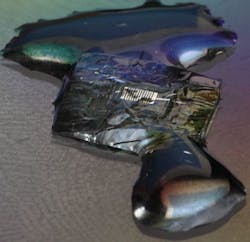SRI International to design vanishing battery for decomposing electronics program
SRI International is joining the Honeywell Aerospace Microelectronics & Precision Sensors segment in Plymouth, Minn., on the VAPR program, which seeks to develop transient electronics that can physically disappear in a controlled, triggerable manner.
DARPA awarded a $4.7 million contract to SRI International last week for the VAPR program. Honeywell won a $2.5 million VAPR contract from DARPA in early December.
Related: Honeywell to investigate transient electronic components able to decompose on demand
The goal of the DARPA VAPR program is to develop electronic components that will decompose on command to prevent unauthorized use and compromise of intellectual property.
Specifically, SRI International's work on the VAPR program centers on a stressed pillar-engineered CMOS technology readied for evanescence (SPECTRE) silicon/air battery -- a transient power supply that, when triggered, becomes unobservable to the human eye.
SRI International experts will design, build, and prove a vanishing silicon/air battery; and move the proven technology to a semiconductor foundry to yield a deployable, realistic, and scalable power supply for use by DARPA customers.
To meet these objectives, SRI International experts will create a self-destructing silicon/air battery that incorporates a platform for CMOS and MEMS circuitry as the battery anode. Company experts will prove performance using an anode that incorporates a representative dielectric film and interconnect.
Overall, researchers from SRI International and Honeywell will work with DARPA to develop new concepts and capabilities to enable the materials, components, integration, and manufacturing to build this new class of disappearing electronics.
Transient electronics may enable revolutionary new military capabilities, including sensors, environmental monitoring over large areas, and simplified diagnosis, treatment, and health monitoring in the field, DARPA officials say.
Large-area distributed networks of sensors that can decompose in the natural environment may provide critical data for a limited time, but no longer. In medical applications, devices that resorb into the body may aid in continuous health monitoring and treatment in the field.
Related: Pentagon stirs up semiconductor industry with its requirement to mark parts with unique DNA
Researchers from SRI International and Honeywell will pursue transient electronics with performance comparable to commercial-off-the-shelf (COTS) electronics, but with limited lifetimes.
Without such capability, DARPA officials say, it is nearly impossible to track and recover every electronic device on the battlefield, which risks technology counterfeiting, unintended accumulation in the environment, and potential enemy use. Once triggered to dissolve, these electronics would be useless to any enemy who might come across them.
“DARPA is looking for a way to make electronics that last precisely as long as they are needed," says Alicia Jackson, the VAPR program manager at DARPA. "The breakdown of such devices could be triggered by a signal sent from command or any number of possible environmental conditions, such as temperature.”
SRI International and Honeywell will conduct basic research into materials, devices, manufacturing and integration processes, and design methodology in transient electronics, culminating in demonstration of a prototype circuit that can accept instructions from a remote user.
For more information contact SRI International online at www.sri.com, Honeywell Microelectronics & Precision Sensors online at www.honeywellmps.com, or DARPA at www.darpa.mil.
